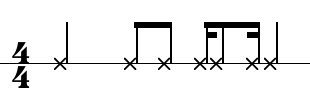
Back to Table of Contents |

 Shape notes
Shape notes Stick notes
Stick notes Stemless notes
Stemless notes X head notes
X head notes
 There are several alternate ways of drawing notes, each of which has a special purpose.
There are several alternate ways of drawing notes, each of which has a special purpose. Shape notes
Shape notes Shape notes have been around for hundreds of years, and are a clever way to depict the diatonic scale in notation. There are two systems, both of which are based on the "movable do" concept, which is that the "do" of do, re, mi is always the tonic note, regardless of what key you are in. This contrasts the "fixed do" system as used in some countries (e.g. France), in which Do always stands for the note C.
Shape notes have been around for hundreds of years, and are a clever way to depict the diatonic scale in notation. There are two systems, both of which are based on the "movable do" concept, which is that the "do" of do, re, mi is always the tonic note, regardless of what key you are in. This contrasts the "fixed do" system as used in some countries (e.g. France), in which Do always stands for the note C.
 The 7-note system is the easiest to understand, representing all seven notes of the diatonic scale. The scale degrees are each represented by a unique shape:
The 7-note system is the easiest to understand, representing all seven notes of the diatonic scale. The scale degrees are each represented by a unique shape:

 Once a student knows how to sing a scale with solfege (Do, Re, Mi...) it's not hard to sing any tune in any key, if the tune sticks to those basic scale notes. And most popular music does. For the rare instances when it does not, you can add sharps or flats to shape notes just as with standard notation.
Once a student knows how to sing a scale with solfege (Do, Re, Mi...) it's not hard to sing any tune in any key, if the tune sticks to those basic scale notes. And most popular music does. For the rare instances when it does not, you can add sharps or flats to shape notes just as with standard notation.
 It's easy to write in Shape Notes with Songworks - there's an option in the Staff Appearance window (see the Staff Menu) that will turn on Shape Notes in a staff. You can enter music either in normal notes or with this option already on: either way, Songworks will automatically pick the correct shape for each note you enter, according to the current key. If you transpose the music or change the key signature, the shapes will change too.
It's easy to write in Shape Notes with Songworks - there's an option in the Staff Appearance window (see the Staff Menu) that will turn on Shape Notes in a staff. You can enter music either in normal notes or with this option already on: either way, Songworks will automatically pick the correct shape for each note you enter, according to the current key. If you transpose the music or change the key signature, the shapes will change too.
 The 4-note system (Tonic Solfa, Sacred Heart) is also supported by Songworks. The four-shape system repeats the same shapes for Do, Re, Mi, and Fa, So, La, since those make the same pattern, and adds one more shape for "Ti," the seventh note:
The 4-note system (Tonic Solfa, Sacred Heart) is also supported by Songworks. The four-shape system repeats the same shapes for Do, Re, Mi, and Fa, So, La, since those make the same pattern, and adds one more shape for "Ti," the seventh note:

 You can change from one system to another, or back to standard notation, by changing the option in the Staff Appearance window. No editing is required.
You can change from one system to another, or back to standard notation, by changing the option in the Staff Appearance window. No editing is required.
 Stick notes
Stick notes Stick notation leaves out the part about pitch, and merely shows the rhythm. This is sometimes useful to instructors. You can set this option in the Staff Appearance window, too. In the below example we've chosen another option as well, which is not to draw the staff at all. We also made the clef invisible, since it isn't needed if the pitch is not indicated.
Stick notation leaves out the part about pitch, and merely shows the rhythm. This is sometimes useful to instructors. You can set this option in the Staff Appearance window, too. In the below example we've chosen another option as well, which is not to draw the staff at all. We also made the clef invisible, since it isn't needed if the pitch is not indicated.

 Stemless notes
Stemless notes Another option in the Staff Appearance menu is stemless notation. This is often seen in liturgical music, and is meant to indicate a free rhythm. Barlines are not necessary, nor is a meter signature (but you'll still want to put one barline at the end of each line so that the music will print neatly).
Another option in the Staff Appearance menu is stemless notation. This is often seen in liturgical music, and is meant to indicate a free rhythm. Barlines are not necessary, nor is a meter signature (but you'll still want to put one barline at the end of each line so that the music will print neatly).

 X-head notes
X-head notes If you set the staff to use X-head notes the result is handy for percussion. In the below example we've also set the option to draw just one staffline:
If you set the staff to use X-head notes the result is handy for percussion. In the below example we've also set the option to draw just one staffline:

Back to Table of Contents |